
Longest Path Task Template and Student Version of Task
- Subject:
- Mathematics
- Material Type:
- Lesson Plan
- Provider:
- VDOE
- Author:
- VDOE
- Date Added:
- 10/07/2024
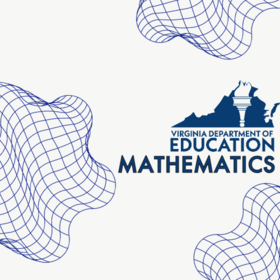
Resources to support Mathematics Standards of Learning for Middle Grades

Longest Path Task Template and Student Version of Task

Pythagorean Theorem Mathematics Instructional Plan
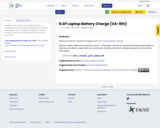
Students view a screenshot of different times throughout the day and remaining cell phone battery percentages. After creating a scatterplot to display the data, students can make inferences and draw conclusions.

This is a performance task where students explore CS concepts, pseudocode, and flowcharts through the lens of order of operations on day 1 and design a math homework helper app on day 2.

Your friend asked you to enter a texting/typing competition but have months to practice. We know practicing something makes you better at it. You will be given your current speed and how well you improve over each month. It is your job to find your texting/typing speed given a number of months that you have practiced. You are also to look over other student’s work to see if they made an error and if so, where.

This video is part of the Continue to Know with WHRO TV series. Watch Fallan Lee-Brown teach about absolute value.
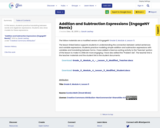
In this lesson, students practice translating between words and algebraic expressions. Students also draw models for these expressions.
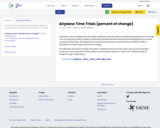
This lesson uses an experiment with paper airplanes to provide data to practice finding percent of change.
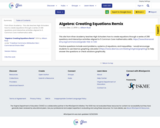
From Khan Academy- This site teaches High Schoolers how to create equations through a series of 298 questions and interactive activities aligned to 5 Common Core mathematics skills.
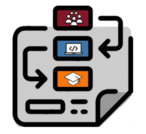
The goal of this activity is to build critical thinking skills and excitement for Computer Science / Computational Thinking, while laying a foundation of fundamental programming concepts. By scaffolding basic concepts like sequencing and algorithms in an unplugged activity, students who are intimidated by computers can still build a foundation of understanding. In this lesson, students will learn how to develop an algorithm and encode it into a program.By "programming" one another to draw pictures, students experience some of the core concepts of programming in a fun and accessible way. The class will start by having students view a video of a simple program demonstrating how to develop instructions for building a peanut butter and jelly sandwich. Students will start with simple shapes, and progress to the coding of a specific drawing that other students will then try to replicate (“running the program”). If there is a desire to have a more of a Math slant on the lesson, the drawing could take place on graph paper. Students would then use the coordinates to complete the drawing.

Compare Histograms to stem-and-leaf, line plots and circle graphs.Mathematics Instructional Plans (MIPs) help teachers align instruction with the 2016 Mathematics Standards of Learning (SOL) by providing examples of how the knowledge, skills and processes found in the SOL and curriculum framework can be presented to students in the classroom.

This lesson incorporates both computer science and mathematics to analyze coding with patterns and proportional relationships. It uses the Turtle library with Python programming.
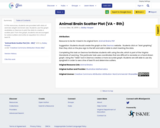
In this resources, students are provided with data of animals weight and brain size. Students use the graph available on Desmos to plot the data to create a scatter plot. From the graph, students are encouraged to notice outliers and write an equation for a line of best fit.
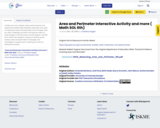
Create your own shapes using colorful blocks and explore the relationship between perimeter and area. Compare the area and perimeter of two shapes side-by-side. Challenge yourself in the game screen to build shapes or find the area of funky figures. The PDF from VDOE was added to create an activity which reviews area and perimeter of triangles and rectangles on paper prior to delving into the fun, interactive activity.

This lesson is on Jamboard. Students will use Desmos calculator to compute the area of the triangles. Students will also use the formula sheet to use the formula for the problems.

"I prefer to think that we arrive at insight by experience..."-Josef Albers Examining art with a mathematical lens can help students articulate how they see and understand spatial and numerical relationships. Use this resoure to explore prints by artist and teacher Josef Albers to help students expand their understanding of geometric concepts such as parallel lines, congruent angles, rectangular prisms and more.The resource includes: Short introduction to Albers and his ideas.Examples of Albers works for examination. Suggested open-ended activity for further exploration Discussion prompts This activity can be structured as introductory exploration or informal formative evaluation. Use student ideas generated as a reference and springboard for more formal instruction and problem-solving.
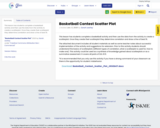
This lesson has students complete a basketball activity and then use the data from the activity to create a scatterplot. Once they create their scatterplot they determine correlation and draw a line of best fit.
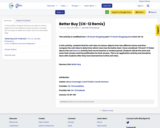
In this activity, students find the unit rates of various objects from two different stores and then compare the unit rates to determine which store has the better deal.
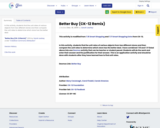
In this activity, students find the unit rates of various objects from two different stores and then compare the unit rates to determine which store has the better deal.
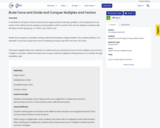
In the field of computer science, there are two approaches to solving a problem. One, being Brute Force, which is the method of just working out the problem until it is solved. This can be related to students with the idea of never giving up, or "I think I can, I think I can". Divide and Conquer is a problem solving method that braeks a larger problem into smaller problems. For example, if you have a big chore such as cleaning a house, start with one room at a time. This lesson applies these two methods to mathematics by using Brute Force to find multiples and common multiple of numbers. While the Divide and Conquer method is applied to fiding factors of a number through divisibility rules.